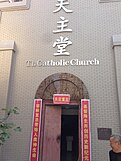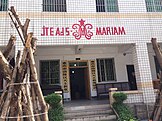Fuling Catholic Church
This article needs additional citations for verification. (August 2017) |
| Fuling Catholic Church | |
|---|---|
 The entrance to the courtyard of Fuling Catholic Church | |
 | |
| 29°43′29″N 107°24′36″E / 29.724696°N 107.410076°E | |
| Location | Fuling District, City of Chongqing |
| Country | China |
| Denomination | Roman Catholic |
| History | |
| Founded | 1861 |
| Founder(s) | French missionaries |
| Architecture | |
| Functional status | Active |
| Architectural type | Church |
| Years built | 1861 1991 (renovated) |
| Specifications | |
| Bells | Yes |
| Administration | |
| Diocese | Jurisdiction: Chinese Patriotic Catholic Association |
Fuling Catholic Church is a Catholic church located in Fuling, China. In the West, it's best known for the description given by Peter Hessler in his book River Town: Two Years on the Yangtze (2001).
History
The church was founded in 1861 by French missionaries. The church also had two French priests until the Cultural Revolution;[1] thereafter, according to written sources, the church was converted into a sock factory by the Red Guards.[2] The priest and the neighborhood, instead, assert that the church itself was just closed down and the sock factory was started in the buildings in front of the church.
In 1981 the church reopened and on the first Sunday less than twenty nervous people went to Mass.[3] The church was renovated in 1991, as stated on the plaque next to the entrance of the church.
The neighborhood
Fuling Catholic Church is located in Fuling historical city center. This area will be heavily renewed in 2017. Many buildings, except the very old ones, will be torn down. After consultation with the government, it has been agreed that the church will not be torn down and rebuilt in Lidu (李渡镇) neighoborhood.[4]
Gallery
-
The entrance to the courtyard - 2017
-
The entrance to the church - 2017
-
The plaque next to the church entrance - 2017
-
The interior of the church - 2017
-
The courtyard - 2017
-
The priest's office - 2017
-
Virgin Mary chapel - 2017
-
Virgin Mary - 2017
References
- ^ Hessler 2001 p. 221
- ^ Hessler 2001 p. 223.
- ^ Hessler 2001 p. 225.
- ^ "涪陵创新旧城改造工作方法" [Methodologies for the innovation and urban renewal of Fuling] (in Chinese). Retrieved 23 April 2017.
Bibliography
Books
- Hessler, Peter (2001). River Town: Two Years on the Yangtze. New York: Harper Perennial. ISBN 0-06-085502-9.








